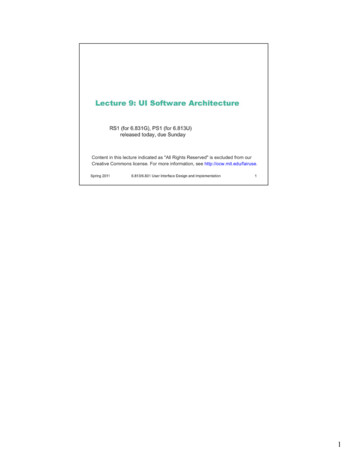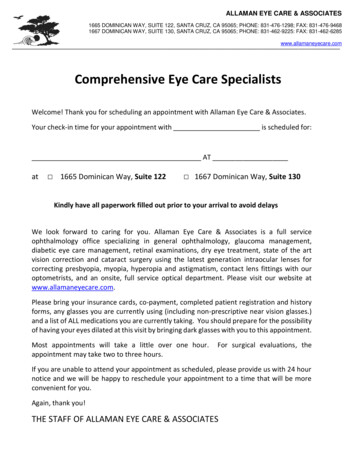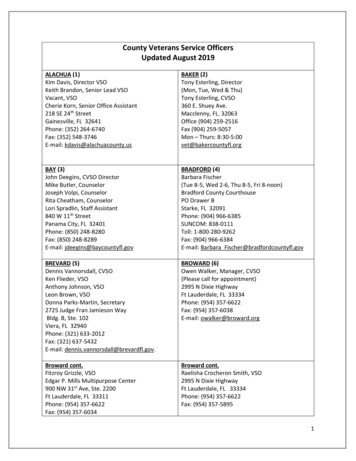
Transcription
&RQWHQW LQ WKLV OHFWXUH LQGLFDWHG DV OO 5LJKWV 5HVHUYHG LV H[FOXGHG IURP RXU &UHDWLYH &RPPRQV OLFHQVH )RU PRUH LQIRUPDWLRQ VHH KWWS RFZ PLW HGX IDLUXVH 1
0LFURVRIW OO ULJKWV UHVHUYHG 0R]LOOD OO ULJKWV UHVHUYHG Today’s candidate for the Hall of Fame or Shame is the modal dialog box.A modal dialog box (like the File Open dialog seen here) prevents the user from interacting with theapplication that popped it up.Modal dialogs do have some usability advantages, such as error prevention (the modal dialog is always ontop, so it can’t get lost or be ignored, and the user can’t accidentally change the selection in the main windowwhile working on a modal dialog that affects that selection).But there are usability disadvantages too, chief among them loss of user control and reduced visibility (e.g.,you can’t see important information or previews in the main window, and can’t scroll the main window tobring something else into view). Modal dialogs may also overload the user’s short-term memory – if the userneeds some information from the main window, or worse, from a second modal dialog, then they’re forced toremember it, rather than simply viewing and interacting with both dialogs side-by-side.When you try to interact with the main window, Windows gives some nice animated feedback – flashing theborder of the modal dialog box. This helps explain why your clicks on the main window had no effect.On most platforms, you can at least move, resize, and minimize the main window, even when a modal dialog isshowing. (The modal dialog minimizes along with it.) Alas, not on Windows the main window iscompletely pinned! You can minimize it only by obscure means, like the Show Desktop command, whichminimizes all windows. This is a big obstacle to user control and freedom.Modeless dialogs, by contrast, don’t prevent using other windows in the application. They’re often used forongoing interactions with the main window, like Find/Replace. One problem is that a modeless dialog box canget in the way of viewing or interacting with the main window (as when a Find/Replace dialog covers up thematch). Another problem is a consistency problem: modal dialogs and modeless dialogs usually lookidentical. Sometimes the presence of a Minimize button is a clue that it’s modeless, but that’s not a very strongvisual distinction. A modeless dialog may be better represented as a sidebar, a temporary pane in the mainwindow that’s anchored to one side of the window. Then it can’t obscure the user’s work, can’t get lost, and isclearly visually different from a modal dialog box.4
SSOH ,QF OO ULJKWV UHVHUYHG On Windows, modal dialogs are generally application-modal – all windows in the application stop respondinguntil the dialog is dismissed. (The old days of GUIs also had system-modal dialogs, which suspended allapplications.) Mac OS X has a neat improvement, window-modal dialogs, which are displayed as translucentsheets attached to the titlebar of the blocked window. This tightly associates the dialog with its window, givesa little visibility of what’s underneath it in the main window – and allows you to interact with other windows,even if they’re from the same application.Another advantage of Mac sheets is that they make a strong contrast with modeless dialogs – the translucent,anchored modal sheet is easy to distinguish from a modeless window.5
Today’s lecture is the first in the stream of lectures about how graphical user interfaces areimplemented. Today we’ll take a high-level look at the software architecture of GUI software,focusing on the design patterns that have proven most useful. Three of the most important patternsare the model-view-controller abstraction, which has evolved somewhat since its originalformulation in the early 80’s; the view tree, which is a central feature in the architecture of everyimportant GUI toolkit; and the listener pattern, which is essential to decoupling the model from theview and controller.We’ll also look at the three main approaches to implementing GUIs, and use that context for a quickintroduction to HTML, Javascript, and jQuery, which together with CSS (next lecture) constitute theuser interface toolkit that we’ll be using in lectures and problem sets in this class. Note that thebackend development of web applications falls outside the scope of the course material in this class.So we won’t be talking about things like SQL, PHP, Ruby on Rails, or even AJAX. For more aboutthat, you may want to check out the 6.470 IAP web programming competition, or the soon-to-beoffered 6.170 web programming software lab.8
(ULF ERXDI OO ULJKWV UHVHUYHG This leads to the first important pattern we’ll talk about today: the view tree. A view is an object thatcovers a certain area of the screen, generally a rectangular area called its bounding box. The viewconcept goes by a variety of names in various UI toolkits. In Java Swing, they’re JComponents; inHTML, they’re elements or nodes; in other toolkits, they may be called widgets, controls, orinteractors.Views are arranged into a hierarchy of containment, in which some views contain other views.Typical containers are windows, panels, and toolbars. The view tree is not just an arbitraryhierarchy, but is in fact a spatial one: child views are nested inside their parent’s bounding box.9
Virtually every GUI system has some kind of view tree. The view tree is a powerful structuring idea,which is loaded with responsibilities in a typical GUI:Output. Views are responsible for displaying themselves, and the view hierarchy directs the displayprocess. GUIs change their output by mutating the view tree. For example, in the wiring diagrameditor shown on the previous slide, the wiring diagram is changed by adding or removing objectsfrom the subtree representing the drawing area. A redraw algorithm automatically redraws theaffected parts of the subtree.Input. Views can have input handlers, and the view tree controls how mouse and keyboard input isprocessed.Layout. The view tree controls how the views are laid out on the screen, i.e. how their boundingboxes are assigned. An automatic layout algorithm automatically calculates positions and sizes ofviews.We’ll look at more about each of these areas in the next three lectures.10
To handle mouse input, for example, we can attach a handler to the view that is called when themouse is clicked on it. Handlers are variously called listeners, event handlers, subscribers, andobservers.11
GUI input event handling is an instance of the Listener pattern (also known as Observer and PublishSubscribe). In the Listener pattern, an event source generates a stream of discrete events, whichcorrespond to state transitions in the source. One or more listeners register interest (subscribe) to thestream of events, providing a function to be called when a new event occurs. In this case, the mouseis the event source, and the events are changes in the state of the mouse: its x,y position or the stateof its buttons (whether they are pressed or released). Events often include additional informationabout the transition (such as the x,y position of mouse), which might be bundled into an event objector passed as parameters.When an event occurs, the event source distributes it to all subscribed listeners, by calling theircallback functions.12
We’ve seen how GUI programs are structured around a view tree, and how input events are handledby attaching listeners to views. This is the start of a separation of concerns – output handled byviews, and input handled by listeners.But we’re still missing the application itself – the backend that actually provides the information tobe displayed, and computes the input that is handled.13
The model-view-controller pattern, originally articulated in the Smalltalk-80 user interface, hasstrongly influenced the design of UI software ever since. In fact, MVC may have single-handedlyinspired the software design pattern movement; it figures strongly in the introductory chapter of theseminal “Gang of Four” book (Gamma, Helm, Johnson, Vlissides, Design Patterns: Elements ofReusable Software).MVC’s primary goal is separation of concerns. It separates the user interface frontend from theapplication backend, by putting backend code into the model and frontend code into the view andcontroller. MVC also separates input from output; the controller is supposed to handle input, and theview is supposed to handle output.The model is responsible for maintaining application-specific data and providing access to that data.Models are often mutable, and they provide methods for changing the state safely, preserving itsrepresentation invariants. OK, all mutable objects do that. But a model must also notify its clientswhen there are changes to its data, so that dependent views can update their displays, and dependentcontrollers can respond appropriately. Models do this notification using the listener pattern, inwhich interested views and controllers register themselves as listeners for change events generatedby the model.View objects are responsible for output. A view usually occupies some chunk of the screen, usuallya rectangular area. Basically, the view queries the model for data and draws the data on the screen.It listens for changes from the model so that it can update the screen to reflect those changes.Finally, the controller handles the input. It receives keyboard and mouse events, and instructs themodel to change accordingly.14
In principle, this separation has several benefits. First, it allows the interface to have multiple viewsshowing the same application data. For example, a database field might be shown in a table and inan editable form at the same time. Second, it allows views and models to be reused in otherapplications. The MVC pattern enables the creation of user interface toolkits, which are libraries ofreusable interface objects.15
A simple example of the MVC pattern is a text field widget (this is Java Swing’s text widget). Itsmodel is a mutable string of characters. The view is an object that draws the text on the screen(usually with a rectangle around it to indicate that it’s an editable text field). The controller is anobject that receives keystrokes typed by the user and inserts them in the string.Instances of the MVC pattern appear at many scales in GUI software. At a higher level, this textfield might be part of a view (like the address book editor), with a different controller listening to it(for text-changed events), for a different model (like the address book). But when you drill down toa lower level, the text field itself is an instance of MVC.16
Here’s a larger example, in which the view is a filesystem browser (like the Mac Finder or WindowsExplorer), the model is the disk filesystem, and the controller is an input handler that translates theuser’s keystrokes and mouse clicks into operations on the model and view.17
The MVC pattern has a few problems when you try to apply it, which boil down to this: you can’tcleanly separate input and output in a graphical user interface. Let’s look at a few reasons why.First, a controller often needs to produce its own output. The view must display affordances for thecontroller, such as selection handles or scrollbar thumbs. The controller must be aware of the screenlocations of these affordances. When the user starts manipulating, the view must modify itsappearance to give feedback about the manipulation, e.g. painting a button as if it were depressed.Second, some pieces of state in a user interface don’t have an obvious home in the MVC pattern.One of those pieces is the selection. Many UI components have some kind of selection, indicatingthe parts of the interface that the user wants to use or modify. In our text box example, the selectionis either an insertion point or a range of characters.Which object in the MVC pattern should be responsible for storing and maintaining the selection?The view has to display it, e.g. by highlighting the corresponding characters in the text box. But thecontroller has to use it and modify it. Keystrokes are inserted into the text box at the location of theselection, and clicking or dragging the mouse or pressing arrow keys changes the selection.Perhaps the selection should be in the model, like other data that’s displayed by the view andmodified by the controller? Probably not. Unlike model data, the selection is very transient, andbelongs more to the frontend (which is supposed to be the domain of the view and the controller)than to the backend (the model’s concern). Furthermore, multiple views of the same model mayneed independent selections. In Emacs, for example, you can edit the same file buffer in twodifferent windows, each of which has a different cursor.So we need a place to keep the selection, and similar bits of data representing the transient state ofthe user interface. It isn’t clear where in the MVC pattern this kind of data should go.18
In principle, it’s a nice idea to separate input and output into separate, reusable classes. In reality, itisn’t always feasible, because input and output are tightly coupled in graphical user interfaces. As aresult, the MVC pattern has largely been superseded by what might be called Model-View, in whichthe view and controllers are fused together into a single class, often called a component or a widget.Most of the widgets in a GUI toolkit are fused view/controllers like this; you can’t, for example, pullout the scrollbar’s controller and reuse it in your own custom scrollbar. Internally, the scrollbarprobably follows a model-view-controller architecture, but the view and controller aren’tindependently reusable.19
Partly in response to this difficulty, and also to provide a better decoupling between the model andthe view, some definitions of the MVC pattern treat the controller less as an input handler and moreas a mediator between the model and the view.In this perspective, the view is responsible not only for output, but also for low-level input handling,so that it can handle the overlapping responsibilities like affordances and selections.But listening to the model is no longer the view’s responsibility. Instead, the controller listens toboth the model and the view, passing changes back and forth. The events receiving high-level inputevents from the view, like selection-changed, button-activated, or textbox-changed, rather than lowlevel input device events).The Mac Cocoa framework uses this approach to MVC.20
Now let’s talk about how to construct the view tree, which will be a tale of three paradigms.In procedural style, the programmer has to say, step-by-step, how to reach the desired state. There’san explicit thread of control. This means you’re writing code (in, say, Javascript or Java) that callsconstructors to create view objects, sets properties of those objects, and then connects them togetherinto a tree structure (by calling, say, appendChild() methods). Java Swing programming was largelyprocedural. Virtually every GUI toolkit offers an API like this for constructing and mutating theview tree.In declarative style, the programmer writes code that directly represents the desired view tree.There are many ways to describe tree structure in textual syntax, but the general convention today isto use an HTML/XML-style markup language. There’s no explicit flow of control in a declarativespecification of a tree; it doesn’t do, it just is. An automatic algorithm translates the declarativespecification into runtime structure or behavior.Finally, in direct manipulation style, the programmer uses a direct-manipulation graphical userinterface to create the view tree. These interfaces are usually called GUI builders, and they offer apalette of view object classes, a drawing area to arrange them on, and a property editor for changingtheir properties.All three paradigms have their uses, but the sweet spot for GUI programming basically lies in anappropriate mix of declarative and procedural – which is what HTML/Javascript provides.21
Our first example of declarative UI programming is a markup language, such as HTML. A markuplanguage provides a declarative specification of a view hierarchy. An HTML element is acomponent in the view hierarchy. The type of an element is its tag, such as div, button, and img.The properties of an element are its attributes. In the example here, you can see the id attribute(which gives a unique name to an element) and the src attribute (which gives the URL of an image toload in an img element); there are of course many others.There’s an automatic algorithm, built into every web browser, that constructs the view hierarchyfrom an HTML specification – it’s simply an HTML parser, which matches up start tags with endtags, determines which elements are children of other elements, and constructs a tree of elementobjects as a result. So, in this case, the automatic algorithm for this declarative specification is prettysimple.22
Boilerplate: DOCTYPE, html, head, and body elements should be part of every HTML file.An element consists of a start tag, attributes, content, and end tag.Case doesn’t matter for tag names and attribute namesAttribute values can be ‘quoted’ or “quoted”or not quoted at all, but it’s better to quoteText outside of a tag is grouped together into a “text node”Whitespace is (mostly) ignoredSome kinds of elements are void (never have an end tag)e.g. img, brthis is often reinforced with an extra slash: img src “ ” / , both to help the reader, andbecause XML parsers demand it before they’ll consider your HTML file (HTML is related toXML, and occasionally they try to play nicely together)Comments look like !---- , , and & need to be escaped: < > & respectively23
Here is a cheat sheet of the most important elements that you might use in an HTML-based userinterface.The div and span elements are particularly important, and may be less familiar to people whohave only used HTML for writing textual web pages. By default, these elements have nopresentation associated with them; you have to add it using style rules (which we’ll explain nextlecture). The div element creates a box, and the span element changes textual properties likefont and color while allowing its contents to flow and word-wrap.HTML has a rather limited set of widgets. There are other declarative UI languages similar toHTML that have much richer sets of built-in components, such as MXML (used in Adobe Flex) andXUL (used in Mozilla Firefox) and XAML (used in Microsoft WPF and Silverlight).We’ll talk more about the output elements, img and canvas, in the output lecture.The script element to embed procedural code (usually Javascript) into an HTML specification.This actually breaks the model of declarative programming, because it introduces an explicit flow ofcontrol! The script elements are executed in the order that they are encountered in parsing theHTML, which means that they might see only a partially-constructed tree.Finally, the style element is used for embedding another declarative specification, CSS stylesheets, which we’ll look at next lecture.24
Here’s procedural code that generates the same HTML view tree, using Javascript and the DocumentObject Model (DOM). DOM is a standard set of classes and methods for interacting with a tree ofHTML or XML objects procedurally. DOM interfaces exist not just in Javascript, which is the mostcommon place to see it, but also in Java and other languages.Note that the name DOM is rather unfortunate from our point of view. It has nothing to do with“models” in the sense of model-view-controller – in fact, the DOM is a tree of views. It’s a model inthe most generic sense we discussed in the Learnability lecture, a set of parts and interactionsbetween them, that allows an HTML document to be treated as objects in an object-orientedprogramming language.Most people ignore what DOM means, and just use the word (pronouncing it “Dom” as in “DomDeLouise”). In fact DOM is often used to refer to the view tree.Compare the procedural code here with the declarative code earlier.Incidentally, you don’t always have to use the setAttribute method to change attributes on HTMLelements. In Javascript, many attributes are reflected as properties of the element (analogous tofields in Java). For example, obj.setAttribute(“id”, value) could also be written as obj.id value.Be warned, however, that only standard HTML attributes are reflected as object properties (if youcall setAttribute with your own wacky attribute name, it won’t appear as a Javascript property), andsometimes the name of the attribute is different from the name of the property. For example, the“class” attribute must be written as obj.className when used as a property.Raw DOM programming is painful, and worth avoiding. Instead, there are toolkits that substantiallysimplify procedural programming in HTML/Javascript -- jQuery is a good example, and the onewe’ll be using.25
Here’s everything you need to know about Javascript. Ha! Not exactly. But Javascript is not a hardlanguage to pick up – it’s a lot like Java and Python in many ways, and you probably already knowJava and Python. Most of the differences are syntactic, which is visible and easy to learn byexample. The trickiest pitfalls in Javascript (or in learning any language) are its semantics.Javascript’s particular semantic pitfalls are variable scoping (which unlike Java is function scoped,not block scoped,and unlike Python it defaults to putting new variables in the global scope ratherthan the local scope) and the semantics of this (which doesn’t behave quite like Java’s this orPython’s self). The variable scoping pitfalls are responsible for both warnings on this slide – (a)never omit the var keyword when you introduce a new variable, and (b) even though you should usevar in your for loops, don’t expect it to behave as in Java – there’s only one variable i for the entirefunction, it isn’t just scoped to the body of the for loop. A corollary of that is that functions youcreate within the body of the for loop all share the same variable i. (See “The Infamous LoopProblem” in cript-scope-and-closures/)A good online tutorial for Javascript is “A re-introduction to JavaScript” (https://developer.mozilla.org/en/JavaScript/A re-introduction to JavaScript).Some good online articles describing the pitfalls of scoping and this: -gotchas.html pt-variable-scope cript-scope-and-closures/ http://www.digital-web.com/articles/scope in javascript/26
jQuery offers a much better way to interact with the DOM than the actual DOM interface. jQuery isa Javascript library that you include in your HTML page. See jquery.com for more details,documentation, and tutorials.The essence of jQuery is selecting a node (or set of nodes) in the DOM and acting on it (gettingproperties, setting properties, or changing tree structure).Selection is done by a pattern language (which is a good pattern language to know because it’s usedin CSS as well, which we’ll be learning about in the next lecture). For example, the pattern #sendfinds a node with the id attribute “send”, .toolbar finds nodes with the class attribute “toolbar”, andbutton just finds all button nodes.jQuery provides a variety of methods for acting on the nodes you find. In general, jQuery methodscome in pairs with the same name: the method with no arguments gets a value, and the method witharguments sets a value. So .text() returns the text contained in the node’s descendents, while .text(“Tweet”) replaces all those descendents with the text node “Tweet”. Similarily, .attr() gets and setsattribute values, .click() sets a mouse event handler (or simulates a click), .val() gets or sets the valueof a text widget, and .html() gets or sets the descendents of a node as HTML.27
To actually create a working interface, you frequently need to use a mix of declarative andprocedural code. The declarative code is generally used to create the static parts of the interface,while the procedural code changes it dynamically in response to user input or model changes. Eveninside the procedural code, we can use declarative code – a template of HTML that is filled withdynamically-computed parts.One issue to think about is whether this template is constructed as a string of characters (as in the topgreen box), or as a data structure of objects (as in the bottom green box). Which do you think isbetter?Note also that the code in the script tag is wrapped in a mysterious (function() { }), which ishighlighted in red. This is jQuery shorthand for (document).ready(function() { })), which is infact an event handler attached to the root of the view tree (the document). This event handler iscalled just once, after the entire HTML file has been parsed and the tree has been constructed. Thisis important to do! Why? Where could we put the script element so that the Send button doesn’teven exist when the script element is executed? This is one of the ways that it’s tricky to combineprocedural and declarative programming.28
Now that we’ve worked through our first simple example of declarative UI – HTML – let’s considersome of the advantages and disadvantages.First, the declarative code is usually more compact than procedural code that does the same thing.That’s mainly because it’s written at a higher level of abstraction: it says what should happen, ratherthan how.But the higher level of abstraction can also make declarative code harder to debug. There’sgenerally no notion of time, so you can’t use techniques like breakpoints and print statements tounderstand what’s going wrong. The automatic algorithm that translates the declarative code intoworking user interface may be complex and hard to control – i.e., small changes in the declarativespecification may cause large changes in the output. Declarative specs need debugging tools that arecustomized for the specification, and that give insight into how the spec is being translated; withoutthose tools, debugging becomes trial and error.On the other hand, an advantage of declarative code is that it’s much easier to build authoring toolsfor the code, like HTML editors or GUI builders, that allow the user interface to be constructed bydirect manipulation rather than coding. It’s much easier to load and save a declarative specificationthan a procedural specification. Some GUI builders do use procedural code as their file format –e.g., generating Java code and automatically inserting it into a class. Either the code generation ispurely one-way (i.e., the GUI builder spits it out but can’t read it back in again), or the proceduralcode is so highly stylized that it amounts to a declarative specification that just happens to use Javasyntax. If the programmer edits the code, however, they may deviate from the stylization and breakthe GUI builder’s ability to read it back in.29
30
0LFURVRIW OO ULJKWV UHVHUYHG Our Hall of Fame or Shame candidate for next time is the command ribbon, which was introduced inMicrosoft Office 2007. The ribbon is a radically different user interface for Office, merging themenubar and toolbars together into a single common widget. Clicking on one of the tabs (“Home”,“Insert”, “Page Layout”, etc) switches to a different ribbon of widgets underneath. The metaphor isa mix of menubar, toolbar, and tabbed pane. Notice how UIs have evolved to the point where newmetaphorical designs are riffing on existing GUI objects, rather than physical objects. Expect to seemore of that in the future.Needless to say, strict external consistency has been thrown out the window – Office no longer hasa menubar or toolbar. But if we were slavishly consistent, we’d never make any progress in userinterface design. Despite the radical change, the ribbon is still externally consistent in someinteresting ways, with other Windows programs and with previous versions of Office. Can you findsome of those ways?The ribbon is also notable for being designed from careful task analysis. How can you tell?31
0,7 2SHQ&RXUVH:DUHKWWS RFZ PLW HGX 8VHU ,QWHUIDFH 'HVLJQ DQG ,PSOHPHQWDWLRQ 6SULQJ )RU LQIRUPDWLRQ DERXW FLWLQJ WKHVH PDWHULDOV RU RXU 7HUPV RI 8VH YLVLW KWWS RFZ PLW HGX WHUPV
ˇ On Windows, modal dialogs are generally application-modal - all windows in the application stop responding until the dialog is dismissed. (The old days of GUIs also had system-modal dialogs, which suspended all applications.) Mac OS X has a neat improvement, window-modal dialogs, which are displayed as translucent sheets attached to the titlebar of the blocked window.











